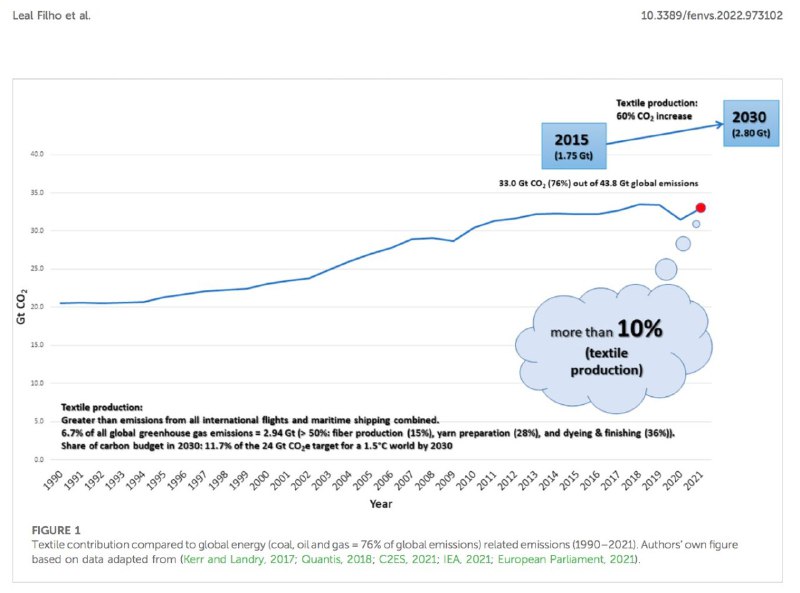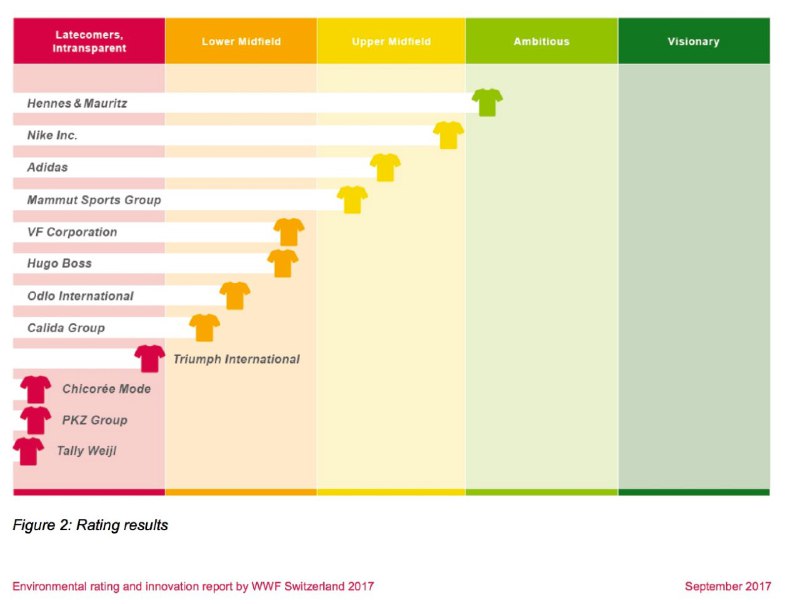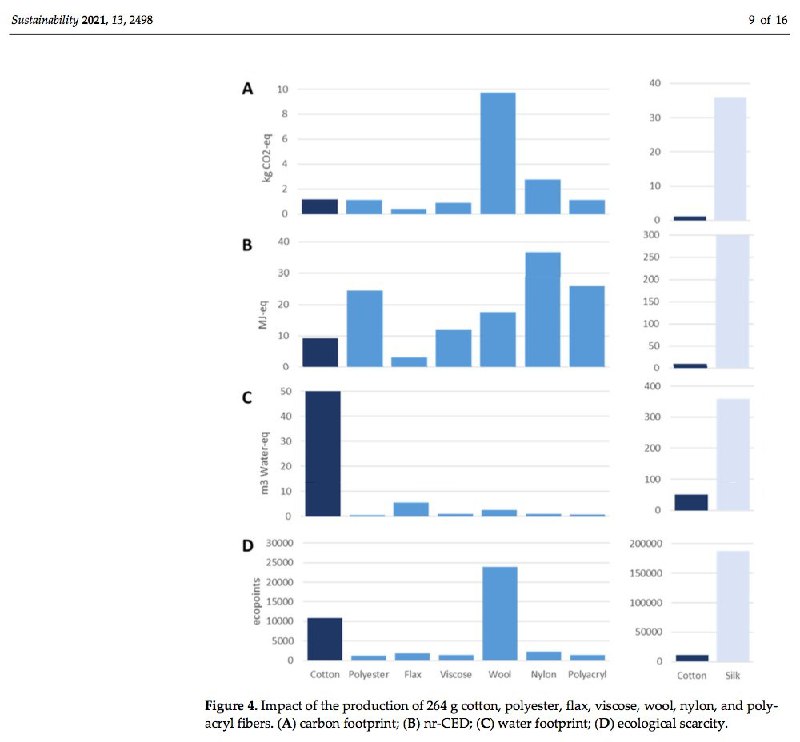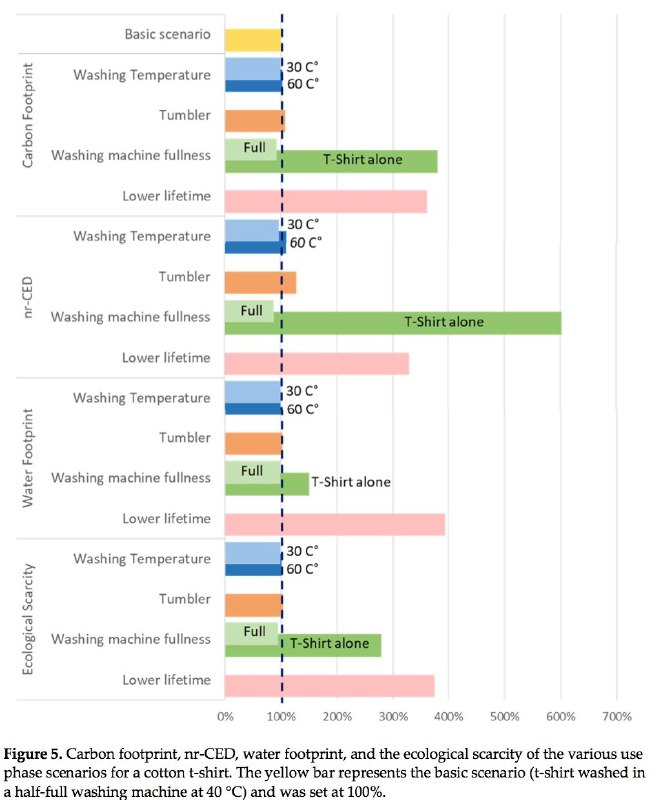tgoop.com »
United States »
Carbon dioxide (CO2) Facts on Telegram by GRT : the true behind global greenhouse gas emissions / planet pollution »
Telegram web »
Post 909
The clothing and textile industry has an ecological footprint which is far from sustainable. The industry emits 1.7 billion tonnes of CO2 annually, is responsible for extensive water use and pollution, and produces 2.1 billion tonnes of waste annually, to name just a few aspects.
Global consumption of clothes doubled be- tween 2000 and 2014. Today, on a global average, every person buys 5kg of clothes per year, but in Europe and the USA the figure is as high as 16kg.
H&M was classified as ‘ambitious’; Nike, adidas and Mammut were ranked in the ‘upper midfield’;
VF Corporation (e.g. The North Face, Timberland), Hugo Boss, Odlo and Calida ended up in the ‘lower midfield’; and Triumph, Chicorée, PKZ and Tally Weijl were classified in the ‘latecomers / intransparent’ group – meaning they take very limited action regarding environmental issues, or do not disclose any information.
Cotton is a water-intensive crop that is usually grown in dry regions so as not to damage the eventual quality of fibre.
Not just cotton, synthetic bres such as polyester, rayon and viscose use much energy and chemicals to produce, often up to five times as much.
Since large-scale production of the synthetic materials began in the early 1950s to 2015, humans have created more than 8.3 billion metric tons of plastics https://perma.cc/NN5V-ZUWS
The textile industry creates 5-10% of global CO2 emissions. At the current rate this could increase to 26% by 2050.
https://www.tgoop.com/FoodWasteTelegram/132
What are microfibers and why are our clothes polluting the oceans? https://perma.cc/2B3Z-7BMA
Once our clothes reach a washing machine, the synthetic fabrics release tiny strands: so-called microfibers. These are essentially microscopic pieces of plastic, just like the microbeads you find in cosmetics.
The IUCN calculates that 35% of this microplastic pollution comes from washing synthetic textiles.
More https://perma.cc/9ZTY-6QYW https://perma.cc/GWP6-UU92
Global consumption of clothes doubled be- tween 2000 and 2014. Today, on a global average, every person buys 5kg of clothes per year, but in Europe and the USA the figure is as high as 16kg.
H&M was classified as ‘ambitious’; Nike, adidas and Mammut were ranked in the ‘upper midfield’;
VF Corporation (e.g. The North Face, Timberland), Hugo Boss, Odlo and Calida ended up in the ‘lower midfield’; and Triumph, Chicorée, PKZ and Tally Weijl were classified in the ‘latecomers / intransparent’ group – meaning they take very limited action regarding environmental issues, or do not disclose any information.
Cotton is a water-intensive crop that is usually grown in dry regions so as not to damage the eventual quality of fibre.
Not just cotton, synthetic bres such as polyester, rayon and viscose use much energy and chemicals to produce, often up to five times as much.
Since large-scale production of the synthetic materials began in the early 1950s to 2015, humans have created more than 8.3 billion metric tons of plastics https://perma.cc/NN5V-ZUWS
The textile industry creates 5-10% of global CO2 emissions. At the current rate this could increase to 26% by 2050.
https://www.tgoop.com/FoodWasteTelegram/132
What are microfibers and why are our clothes polluting the oceans? https://perma.cc/2B3Z-7BMA
Once our clothes reach a washing machine, the synthetic fabrics release tiny strands: so-called microfibers. These are essentially microscopic pieces of plastic, just like the microbeads you find in cosmetics.
The IUCN calculates that 35% of this microplastic pollution comes from washing synthetic textiles.
More https://perma.cc/9ZTY-6QYW https://perma.cc/GWP6-UU92
tgoop.com/PollutionFacts/909
Create:
Last Update:
Last Update:
The clothing and textile industry has an ecological footprint which is far from sustainable. The industry emits 1.7 billion tonnes of CO2 annually, is responsible for extensive water use and pollution, and produces 2.1 billion tonnes of waste annually, to name just a few aspects.
Global consumption of clothes doubled be- tween 2000 and 2014. Today, on a global average, every person buys 5kg of clothes per year, but in Europe and the USA the figure is as high as 16kg.
H&M was classified as ‘ambitious’; Nike, adidas and Mammut were ranked in the ‘upper midfield’;
VF Corporation (e.g. The North Face, Timberland), Hugo Boss, Odlo and Calida ended up in the ‘lower midfield’; and Triumph, Chicorée, PKZ and Tally Weijl were classified in the ‘latecomers / intransparent’ group – meaning they take very limited action regarding environmental issues, or do not disclose any information.
Cotton is a water-intensive crop that is usually grown in dry regions so as not to damage the eventual quality of fibre.
Not just cotton, synthetic bres such as polyester, rayon and viscose use much energy and chemicals to produce, often up to five times as much.
Since large-scale production of the synthetic materials began in the early 1950s to 2015, humans have created more than 8.3 billion metric tons of plastics https://perma.cc/NN5V-ZUWS
The textile industry creates 5-10% of global CO2 emissions. At the current rate this could increase to 26% by 2050.
https://www.tgoop.com/FoodWasteTelegram/132
What are microfibers and why are our clothes polluting the oceans? https://perma.cc/2B3Z-7BMA
Once our clothes reach a washing machine, the synthetic fabrics release tiny strands: so-called microfibers. These are essentially microscopic pieces of plastic, just like the microbeads you find in cosmetics.
The IUCN calculates that 35% of this microplastic pollution comes from washing synthetic textiles.
More https://perma.cc/9ZTY-6QYW https://perma.cc/GWP6-UU92
Global consumption of clothes doubled be- tween 2000 and 2014. Today, on a global average, every person buys 5kg of clothes per year, but in Europe and the USA the figure is as high as 16kg.
H&M was classified as ‘ambitious’; Nike, adidas and Mammut were ranked in the ‘upper midfield’;
VF Corporation (e.g. The North Face, Timberland), Hugo Boss, Odlo and Calida ended up in the ‘lower midfield’; and Triumph, Chicorée, PKZ and Tally Weijl were classified in the ‘latecomers / intransparent’ group – meaning they take very limited action regarding environmental issues, or do not disclose any information.
Cotton is a water-intensive crop that is usually grown in dry regions so as not to damage the eventual quality of fibre.
Not just cotton, synthetic bres such as polyester, rayon and viscose use much energy and chemicals to produce, often up to five times as much.
Since large-scale production of the synthetic materials began in the early 1950s to 2015, humans have created more than 8.3 billion metric tons of plastics https://perma.cc/NN5V-ZUWS
The textile industry creates 5-10% of global CO2 emissions. At the current rate this could increase to 26% by 2050.
https://www.tgoop.com/FoodWasteTelegram/132
What are microfibers and why are our clothes polluting the oceans? https://perma.cc/2B3Z-7BMA
Once our clothes reach a washing machine, the synthetic fabrics release tiny strands: so-called microfibers. These are essentially microscopic pieces of plastic, just like the microbeads you find in cosmetics.
The IUCN calculates that 35% of this microplastic pollution comes from washing synthetic textiles.
More https://perma.cc/9ZTY-6QYW https://perma.cc/GWP6-UU92
BY Carbon dioxide (CO2) Facts on Telegram by GRT : the true behind global greenhouse gas emissions / planet pollution










Share with your friend now:
tgoop.com/PollutionFacts/909
